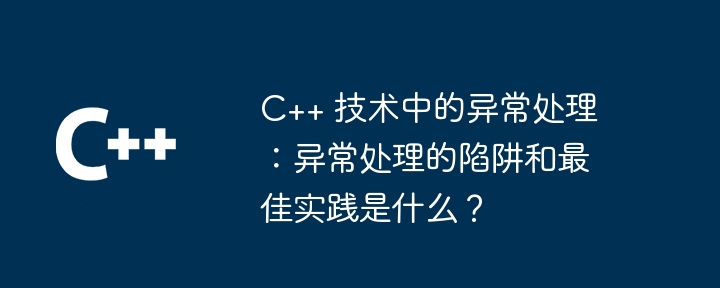
Handling exceptions in C is critical because it allows the program to detect and handle runtime errors. Common pitfalls include uncaught exceptions, overused exceptions, and duplicate exception handling. Best practices include using try-catch blocks, specific exception types, meaningful exception messages, logging, and error handling strategies. Practical cases demonstrate the use of exception handling to catch and handle exceptions and implement error handling strategies.

Exception handling in C technology: pitfalls and best practices for exception handling
Handling exceptions in C programs is the most important Crucially, it prevents the program from crashing when it encounters unexpected conditions. Exception handling allows programs to detect and handle runtime errors and provide elegant error reporting.
Traps in exception handling
There are several common pitfalls to avoid when writing exception handling code:
Best Practices for Exception Handling
Achieving efficient and robust exception handling requires following the following best practices:
try-catch block to catch and handle exceptions. The try block contains the code to be executed, while the catch block contains the code to handle the exception. std::runtime_error or a custom exception class. This provides more accurate and useful error reporting. Practical case
Consider the following C code segment to demonstrate exception handling:
#include <iostream>
#include <exception>
int main() {
try {
// 代码可能引发异常
throw std::runtime_error("错误发生!");
} catch (const std::exception& e) {
// 捕获并处理异常
std::cout << "异常类型:" << e.what() << std::endl;
// 错误处理策略
return -1;
}
// 成功返回
return 0;
}In this code segment, try blocks contain code that may throw exceptions. If an exception occurs, it is caught and passed to the catch block. The catch block handles exceptions, prints the exception type and message, and implements error handling strategies (such as returning an error code).
By following exception handling pitfalls and best practices, you can write robust C programs that handle exception situations in an elegant manner.
The above is the detailed content of Exception Handling in C++ Technology: What Are the Pitfalls and Best Practices for Exception Handling?. For more information, please follow other related articles on the PHP Chinese website!
 What are the differences between c++ and c language
What are the differences between c++ and c language
 Recommended learning order for c++ and python
Recommended learning order for c++ and python
 Cost-effectiveness analysis of learning python and c++
Cost-effectiveness analysis of learning python and c++
 Is c language the same as c++?
Is c language the same as c++?
 Which is better to learn first, c language or c++?
Which is better to learn first, c language or c++?
 The difference and connection between c language and c++
The difference and connection between c language and c++
 C++ software Chinese change tutorial
C++ software Chinese change tutorial
 Cost-effectiveness analysis of learning python, java and c++
Cost-effectiveness analysis of learning python, java and c++




